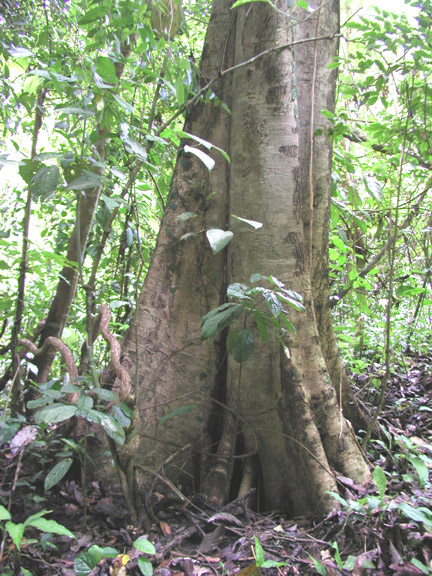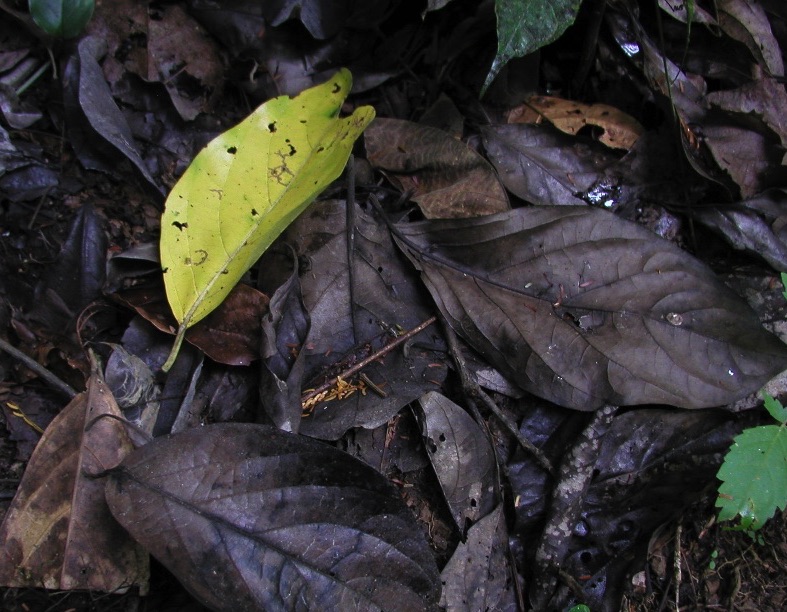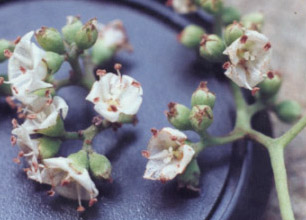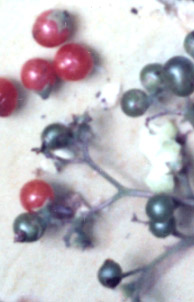Cordia collococca (L.)
Boraginaceae MUÑECO, BURIOGRE
Tree: Occasional evergreen canopy tree (25-35 m) found most frequently in old secondary forest habitats. This is a hardy, light loving species most notable for its eye-catching clusters of bright-red berry-like fruits.
Description: Muñeco trunks (60 cm) are mostly straight, though usually quite irregular in cross-section. Near its base, the bole forms broad, vertical folds bounded by deep creases: structures that diverge into rounded and snaking buttress roots that extend away from the trunk for several meters at ground level. Muñeco bark is off-white in color and made moderately rough by the frequent occurrence of coin-sized, pockmark-like depressions. are restricted to the very top of the bole and they create a moderately thick, single-layered crown that is often wide and spreading.
Simple and alternately arranged, the leaves (12 cm by 7 cm) are characteristically thick, stiff, and abrasive – with a texture resembling fine sandpaper. The blades possess an elliptical shape and a rounded, drip-tip-less apice. As Muñeco leaves senesce, they grade from green through yellow, finally ending a deep, chocolate brown color before being shed and then regrown. Rot-resistant, the dead foliage is often found carpeting the forest floor underneath these trees. Usually, this process of leaf renewal occurs in July and then again in February. Poorly synchronized among individual Muñeco trees, it may nevertheless be observed at sporadic intervals during other months as well. Muñeco crowns remain completely bare for only about a week.
Flowers (8 mm) are produced in large axillary panicles. Each has a white corolla, formed from five, partially fused white petals and supported by a small, green calyx. Five brown stamens are attached to the petals and a four-part pistil with a bulbous red ovary is positioned at the center of the blossom. Flowers appear mainly in June or July, but lesser, poorly synchronized flowering events have been observed in September and April as well.
Fruits (1 cm) are small drupes that mature as they turn from green to bright-red. Large bunches of them appear high in the canopy about a month after the blossoms die. Each drupe is fleshy and juicy, with a thick, mucilaginous consistency, and contains one small (0.5 cm), somewhat flattened and wrinkled white seed. Fruits appear in abundance in from late July through September but may also occur in lesser numbers during other months.
Similar Species: To distinguish this species from other trees with similar leaf type and arrangement, look for its irregular, broadly folded, whitish trunk. An accumulation of thick and roughly textured leaves on the ground around the bole is a further indication that the tree is a Muñeco. Cordia collococca is one of four Cordia species found in Manuel Antonio National Park (the others being C. alliodora – Laurel, C. bicolor, C. curassavica). All share similar foliage characteristics as well as the hardy, secondary, growth habit.
Natural History: Flowers are insect pollinated and fruits are eaten mainly by birds. Muñeco is a relatively long-lived and large-growing secondary – or pioneer – species that thrives under the harsh conditions characteristic of exposed locations.
Uses: Other than as an important fruit producing species for native fauna, this tree appears to have potential use as a timber tree. The wood is tan colored with dark rays, it is moderately heavy, and it is easy to work (Witsberger, 1982). Muñeco could also serve as a very useful species in reforestation efforts, since it withstands intense insolation, grows quickly, provides shade, and generates food appealing to wildlife.
Distribution: In Costa Rica, Muñeco is known from Manuel Antonio, Punta Leona, Carara, and Corcovado, and it probably is native to the entire southern Pacific lowland slope of this country. The species ranges from southern Mexico to Costa Rica (Witsberger, 1982).




